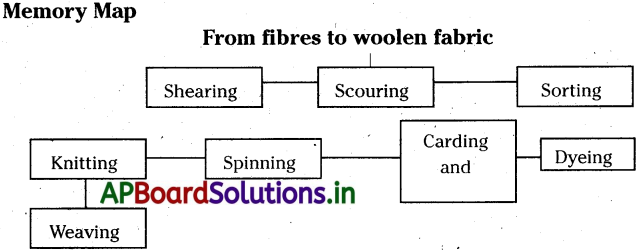Students can go through AP Board 7th Class Science Notes 11th Lesson Fibres and Fabrics to understand and remember the concept easily.
AP Board 7th Class Science Notes 11th Lesson Fibres and Fabrics
→ Fibres are derived from plants, animals as well as chemicals.
→ Silk is derived from Silkmoth.
→ Wool is derived from animals like sheep, goat, yak and camel.
→ Marino sheep is the world famous breed for wool rearing.
→ Sheep is the main source of wool production in Andhra Pradesh.
→ Angora goat is the world wide famous breed for wool.
→ Rearing or farming of sheep is a branch of animal husbandry in India.
→ Fleece is used to make wool.
![]()
→ There are 6 stages in processing fibres into wool.
→ They are shearing, scouring, sorting, dyeing, carding, combing and spinning.
→ Removing fleece of animal along with the outer thin layer of skin is called shearing.
→ The process of separating the fleece of animal into sections based on its quality is known as sorting.
→ The process of wrapping the fleece between the two surfaces to make the fibre into a fluffy roll is called carding.
→ Process of winding together the fibres to form a yarn is called Spinning.
→ Larvae and caterpillars are called silkworms.
→ The capsule like structure is known as cocoon (pattukaaya).
→ Rearing of silkworms for obtaining silk is known as Sericulture.
→ Andhra Pradesh stands in second place in the production of silk in the country.
→ The process of killing larvae inside the cocoon by putting them in steam is called stifling.
→ The process of extracting threads from cocoon is called Reeling.
→ The Scientific name of the Silk moth that yields silk is known as Bombyx mori.
→ The silk obtained from bombyx mori is called Mulberry silk.
→ Animal fibres burn slowly but not continuously when compared to plant fibres. Animal fibres dissolve in Chlorine based bleach.
![]()
→ Keratin is the major protein present in wool.
→ Silk fibres are made of protein are called fibroin.
→ Artificial fibres or synthetic fibers are made of chemicals obtained from wood pulp or petroleum.
→ Examples for artificial fibres are Acrylic, Rayon, Nylon, Polyester etc.
→ Except Rayon, remaining artificial fibres are made of chemicals, their productions causes environmental pollution.
→ Clothes made of animal fibres (wool, silk) should be stored carefully preventing the attack of insects.
→ The process of removal of shrinkage from silk clothes is called Rolling.
→ Mohair : The wool derived from Angora goat.
→ Shearing : Removing fleece of animals along with the outer thin layer of skin is called shearing.
→ Scouring : To remove dirt or grease from (cloth or fibres) by means of a detergent.
→ Sorting : The process of separating the fleece of animal into sections based on its quality is known as sorting.
→ Dyeing : To colour (a material), especially by soaking in a colouring solution.
→ Combing : The pulling of fleece through the metal teeth of a combing machine is called combing.
→ Carding : The process of wrapping the fleece between the two surfaces to make the fibre into a fluffy roll is called carding.
→ Spinning : The process of winding together the fibres to form a yarn is called spinning.
→ Knitting : The process of making woolen garment is known as knitting.
→ Cocoon : The capsule like structure formed by silk worm is known as cocoon (pattukaaya).
→ Sericulture : Raising silkworms in order to obtain raw silk.
→ Reeling : The process of extracting threads from cocoon is called Reeling.
→ Bleach : To remove the colour from, as by means of chemical agents or sunlight.
→ Keratin : Major protein present in wool.
![]()
→ Fibroin : Protein present in the silk fibres is fibroin.
→ Acrylic : Artificial fibre prepared from a synthetic fibre acrylic used to make sweaters and shawls.
→ Nylon : First fully synthetic fibre made in 1931, from coal and water. It is strong, elastic and light weight.
→ Polyester : It is used to make shirts, sarees and other dresses. It- doesn’t get wrinkled easily.
→ Synthetic fabrics : The artificial fibres made from wood pulp or petroleum.
→ Recycle : The process of waste products to regain materials for human use.
→ Wrinkles : Formation of foldings in animal fibres (wool and silk) due to poor maintenance.
1.

2.
